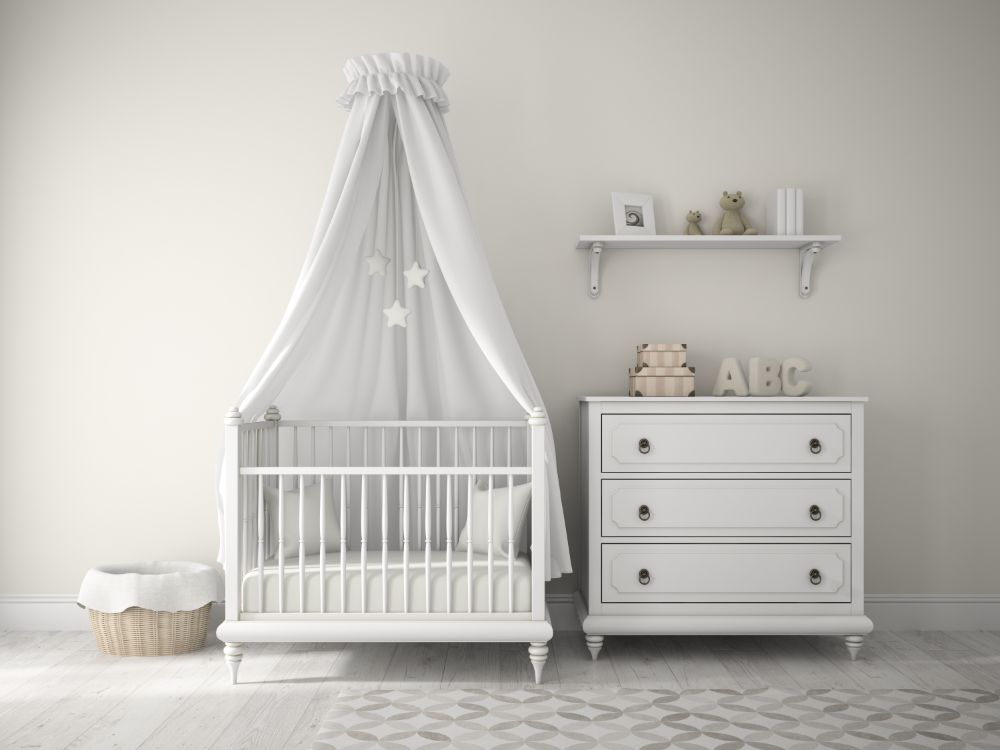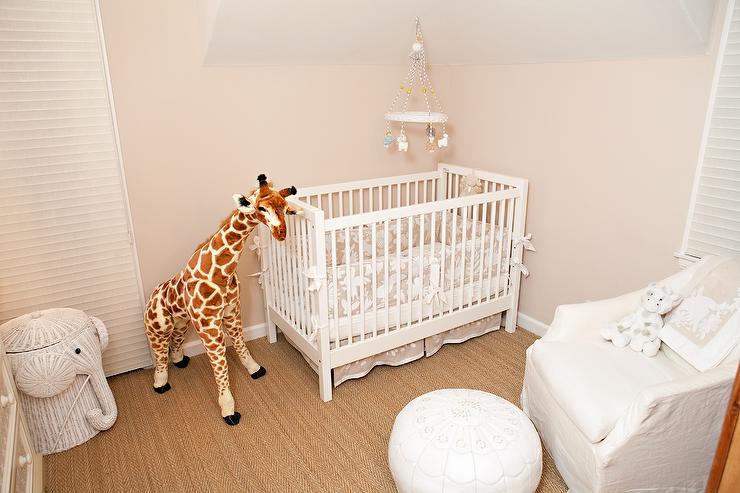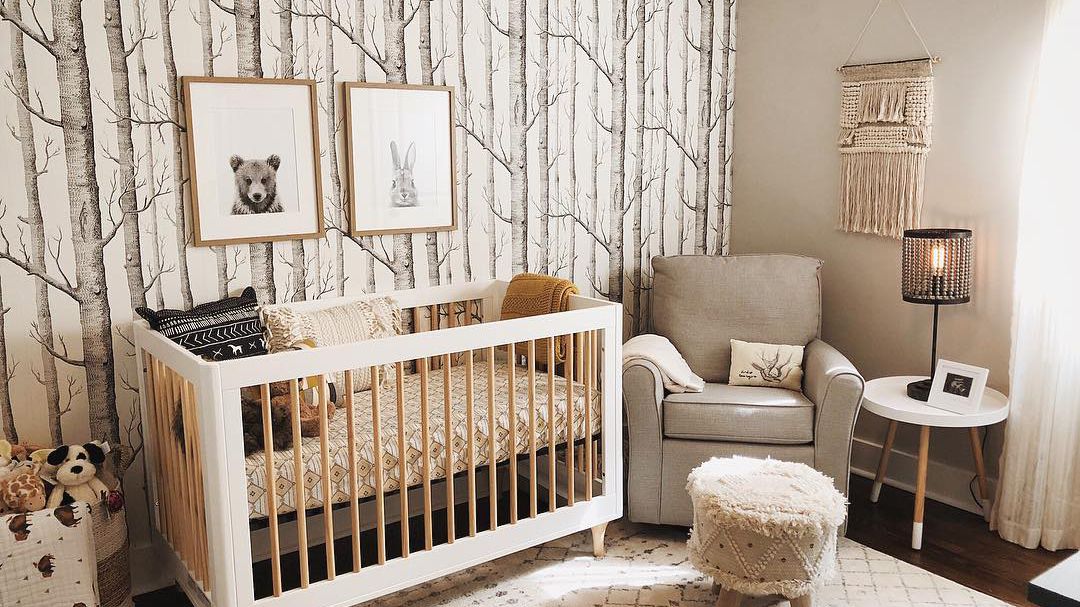Why do you need a nursery checklist?
You need a checklist because time is of the essence when it comes to your little ones. You'll want to make sure you have everything in place before they arrive, and you won't want to forget anything important.
Cribs And Cradles
One of your first priorities will be acquiring a crib or cradle for the baby's room. This should be one of the first purchases that you make after choosing a nursery theme since it is distinctly more important than most other furnishings.
However, if financial circumstances are tight, buying second-hand may be an option worth exploring. Make sure that there are no missing screws or loose pieces with used items, as any defects could pose a danger for your baby.
Bedding Sets
Keep in mind that bedding sets are normally well worth the extra expenditure. Carefully consider this choice when you are selecting your baby's crib or cradle, since mismatching pieces may look odd if they aren't perfectly coordinated.
The most important piece of the bedding set is the bumper pad, which helps to keep your infant from getting too close to the sides of his or her crib and hurting themselves. Most modern babies' beds come with a detachable one, but you can also buy them separately if necessary.
Baby Monitor
When it comes to safety, nothing is more important than baby monitors. There have been too many cases of parents leaving their children alone in the nursery to go check on dinner or answer the phone, only to come back and find that an accident has occurred.
To keep you from ever having to face such a tragedy, wireless monitors have been developed which use high-frequency sound waves instead of more traditional visual systems.
Attractive Window Treatments
Keep your baby's nursery as bright as possible with attractive window treatments. In addition to blocking out sunlight – which is something that even black-out curtains cannot do – they will also help shield him or her from prying eyes outside. Be sure there are no loose cords, ties, or other potential safety hazards involved before you buy any type of hanging shade or drape.
Crib Bedding
It's important to buy comfortable crib bedding for your infant since they will spend most of their time sleeping in the nursery. Blankets can be especially decorative and warm, but you should never let your baby sleep with one, as some haven't been thoroughly sterilized after manufacturing.
If a blanket is absolutely necessary – perhaps during a trip – always keep it tucked beneath the mattress so that it isn't within reach of tiny hands and inquisitive mouths. Hooded towels can also double as blankets if necessary – just make sure that you take them out of the nursery after bath time so they don't get mixed up with dirty laundry!

Beddy-Bye Sleep Positioners
Not everyone agrees on the safety of these items, but be sure you have at least one Beddy-Bye Sleep Positioner in your nursery. If your baby is unable to roll over onto his or her stomach while sleeping, there's a chance that he or she will suffocate on their own bedding if they are allowed to sleep face down. These inexpensive positioners can save lives by preventing this common occurrence, so it's best not to scrimp when purchasing them for your little ones.
Crib mattress pad
A high-quality crib mattress pad is absolutely essential, not only for your baby's comfort but also for his or her safety. Even when babies are old enough to sleep in a regular bed, using this type of soft under-mattress pad will prevent them from getting too close to the edge and falling out.
Some of these pads even come with fitted sheets made out of soft cotton or breathable polyester, which won't make your little one sweat while he or she is sleeping.
Nightlight With Sensor (Motion Lights)
There's no right or wrong answer when it comes to nightlights. If you want more than one in the nursery, that's okay, but think about how much light your baby needs before you buy one.
If you have a motion sensor light, it will only turn on when someone or something enters the room, which can potentially save on your electric bill as well as keep your baby from being startled by bright light suddenly shining in his or her eyes.
Changing table and diapers items
Having a changing table with all of the necessary accessories will make diaper changes simpler and safer for both you and your infant. So, take a trip to your local department store or baby boutique and pick out some high-quality items before you bring home that adorable crib bedding ensemble!
Cotton swaddling blankets
Newborns don't need many clothes at this stage in their life, but they do need lots of warm cotton swaddling blankets. Babies like to be bundled up when they sleep, which is why these soft fabrics are perfect for creating cozy sleeping environments.
You can also use these to keep them clean while changing them if room temperature water isn't available; just wipe off any dirty areas first.
Crib sheets
You will need to change your baby's crib sheets frequently, so make sure you buy enough. For the first few months of life, you'll likely be changing them at least once per week; after that, it will depend on how often they spit up or have accidents during naps and nighttime sleep. Babies over four months old should only require sheet changes every two weeks at the most!
A rocking chair
You'll be spending plenty of time in the nursery, so you might as well make yourself comfortable when you're there. Rocking chairs are probably more expensive than other options like pillows or cushions placed on kitchen or dining room chairs, but they will last longer.
Plus, they typically come with matching ottomans, which is an added bonus for resting your feet after a long day at work!
Car seat and base
A car seat is essential if you plan to transport your baby anywhere outside the home by automobile. They must always ride in one of these correctly fitted safety devices, even when you're just running errands around town. Just remember that younger babies should be transported in rear-facing car seats, as they are five times safer than the forward-facing type.
A diaper pail
You'll need a diaper pail to keep all of those dirty diapers in check throughout the day and night. Look for one with a tightly closing lid that locks so you won't have to worry about odor or insects, as well as one with rubber seals on top so your little one's feces don't come out while changing the bag!

Rock 'n Play Sleeper
While it might seem more convenient to let your baby sleep in his or her car seat instead of buying a new product, this is not safe or recommended by most pediatricians and infant care experts. Instead, buy a Rock 'n Play sleeper, which has been deemed a safe alternative since its introduction several years ago. This light device can be moved from room to room in your home so you can keep an eye on your baby without having to get up.
A hamper
You'll need a hamper to store all of your little one's dirty clothes in. Make sure it is made from a breathable material with at least eight handles, so you can easily carry full bags around the house when it's time to do laundry.
Clothing chair
If you don't have enough chairs in the nursery, invest in a clothing chair. This type of furniture is typically small, multi-functional, and looks great in any room. It's also stackable, so you can stow it under your changing table or dresser when not in use.
A diaper stacker
Diaper stackers are ideal for hanging on the side of your baby's crib once he or she has started sleeping through the night. They feature cute patterns with cute animals on them to add a fun element to any nursery design scheme!
A mobile toy bar
Many parents assume that babies will get bored staring at their crib walls while they sleep or play during their first few months of life, which is why investing in a mobile, also known as a toy bar, is important. These types of products can be moved from room to room with ease, so you won't have to worry about your baby getting bored while you're busy cooking or cleaning!
What are the main features of a good nursery?
A good nursery will have plenty of storage space for all of your child's clothing, toys, supplies, and other items. It should also include a changing table to keep all of those necessary baby accessories like clothes, diapers, wipes, creams, etc. within arms' reach at all times!
It's important to make sure your little one has enough clothing options with plenty of shirt colors and combinations, as well as pants or shorts in several different hues. If you want to go the extra mile, you can even buy two-piece outfits with matching shoes!
What colors should prevail in your nursery?
The colors you choose for your nursery will depend on the gender of your child, so find out soon if you want to paint or hang wall decor with a particular color scheme. If you know what sex your little one is and don't plan to surprise anyone by waiting until birth, stick to the traditional girl and boy neutrals like light pink and dark blue.
Once you've chosen the perfect color palette, add in some accent furniture pieces that complement it. Stick to just a few different elements in terms of furniture shapes and patterns, as having too many options can overwhelm designers and new parents alike!
What should you avoid when planning the nursery?
To avoid design mistakes while planning your baby's room, you should never buy anything that is too small or made from cheap fabric. Also, steer clear of products with sharp corners and edges, since your child will be crawling around this space before long.
How to decorate the nursery?
The best way to decorate your baby's nursery is to start with a blank slate and add-in products one by one until you have a fully functional and aesthetically pleasing room.
Hang curtains to give the illusion of a window when there isn't any in order to make your child feel more at home in his or her new space. Add in some photos from before birth, as well as ones are taken specifically for the nursery, to add an extra personalized touch!
Once you've installed all necessary furniture and accessories in this area of your home, add in whatever extras make sense based on the color scheme and theme. For example, if you wanted an underwater animal-themed room, try creating wall art featuring whales, dolphins, and turtles!
How can you save money when planning the nursery?
The best way to save money when planning your baby's room is to buy in bulk, which will lower your per-piece cost. Buying clothing sets in various sizes for both gender options is a surefire way to get the most bang for your buck. Also, buying toys and other items in sets will help you cut extra costs while still making sure there are plenty of fun things for your little one to play with!
Also, buying products that are on sale or clearance will save you a ton of money! You can easily plan your baby's entire room around one giant shopping trip to the local department store, especially if it has an attached baby section.

What is the best way to organize the nursery?
The best way to keep this area of your home organized is by installing shelving units and lockers for items like clothing, toys, books, etc. Using these types of products will keep things off surfaces where they might get dirty, as well as make them easy to find when you're looking for specific items down the road!
Once everything is in its place, try adding decorative touches that don't disturb this organizational scheme. Adding wall art with colorful patterns that help the eye follow around the room is a great way to tie everything together!
What are some typical nursery themes?
There are many different types of baby room themes, but one of the most common is an ocean design. This color choice features bright blues, whites, and yellows in order to recreate a tropical-like environment for an infant.
Other popular themes include jungle animals like lions, giraffes, elephants, etc., woodland creatures, astronauts, outer space-themed rooms, farm animals, and more! The possibilities are endless!
Final words
To help you plan your baby's room, this article has given helpful information about choosing a palette, decorating the nursery, avoiding design mistakes, and more.
Remember to plan for future children by going with neutral colors and quality materials, as well as to buy in bulk if possible! Most importantly, make sure you have fun designing a place where your child can grow up healthy and happy!